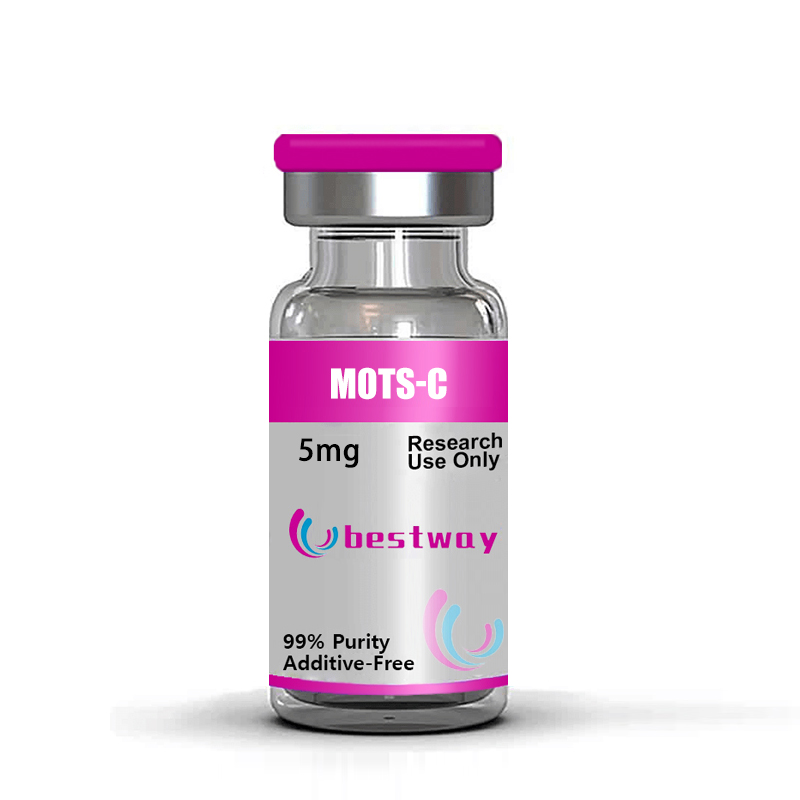Class of Compound:
Peptide
Mechanism of Action:
While the precise mechanism of action of MOTS-c is currently under investigation, it is hypothesized that its metabolic effects are mediated through its translocation to the nucleus and subsequent activation of AMPK.
Notable Studies:
· MOTS-c peptide regulates adipose homeostasis to prevent ovariectomy-induced metabolic dysfunction.
· The mitochondrial-derived peptide MOTS-c promotes metabolic homeostasis and reduces obesity and insulin resistance.
· MOTS-c Functionally Prevents Metabolic Disorders. Metabolites.
What is MOTS-c?
MOTS-c, is a mitochondrial-derived peptide, consisting of 16 residues encoded by the 12S rRNA region of the mitochondrial genome. This means that the genetic information that is translated into the peptide’s amino acid sequence has not been processed into a strip of mRNA. Rather, the peptide is translated from a strand of rRNA whose main role is not to carry genetic information but to help ribosomes work in processing such information. MOTS-cwas discovered in 2015 and has since attracted attention for its potential role in metabolic regulation and age-related conditions.
MOTS-c has been found to have various effects on cellular metabolism, insulin sensitivity, mitochondrial function, and aging processes .
Studies suggest that MOTS-c may:
· Improve glucose uptake and utilization
· Enhance insulin sensitivity
· Promote mitochondrial biogenesis (the formation of new mitochondria)
· Reduce oxidative stress
These effects may contribute to improved metabolic health and cellular function, with potential implications for the management of diabetes, obesity, and age-related diseases.

What Does MOTS-c Do?
In a study by Kim et al. (2018), it was demonstrated that MOTS-c can translocate to the nucleus in response to metabolic stress. This translocation allows MOTS-c to modulate adaptive gene expression in the nucleus.
MOTS-c is also referred to as a "mitochondria hormone" or "mitokine" due to its release into the bloodstream. Along with humanin, MOTS-c is one of the more extensively studied mitochondrial-derived peptides (MDPs). While humanin can bind to various receptors, no specific receptors have been identified for MOTS-c.
The circulation of MOTS-c is regulated in part by the folate cycle, and its expression is influenced by age. Studies show that endogenous levels of this peptide tend to decline as individuals grow older .
Under conditions of stress, MOTS-c undergoes translocation from the mitochondria to the nucleus. Through this mechanism, MOTS-c modulates levels of the enzymes known as activated protein kinase (AMPK) and 5-aminoimidazole-4-carboxamide ribonucleotide (AICAR), both essential regulators of energy homeostasis .
Overall, MOTS-c serves as a key mediator of metabolic functions. In this capacity, it has shown the potential to address metabolic disorders such as postmenopausal insulin resistance and obesity. Studies also suggest anti-aging outcomes enacted through distinct age-related pathways, as well as cardiometabolic benefits attributed to its role in cellular energy homeostasis .
Further research is needed to fully understand the intricate mechanisms by which MOTS-c modulates cellular metabolism and its potential implications for various physiological and pathological conditions.
MOTS-c Benefits | Clinical Trials
MOTS-c has demonstrated promise in preclinical studies, suggesting several potential benefits. Although further research is required to fully understand its therapeutic applications, here are some of the potential benefits associated with MOTS-c per findings to date:
MOTS-c for metabolic disorders:
Postmenopausal women often experience hormonal changes that can lead to metabolic dysfunction and an increased risk of conditions such as obesity and impaired insulin sensitivity. A study conducted by Lu et al. (2019) investigated the effects of MOTS-c treatment on these metabolic changes in mice that underwent ovariectomy.
The study found that ovariectomy resulted in increased fat mass and disrupted adipose tissue function, leading to insulin resistance. However, MOTS-c treatment prevented the development of obesity and insulin resistance. The treatment was also associated with the activation of brown fat, reduced adiposity, and lowered inflammation, ultimately resulting in decreased levels of fatty acids in the blood and liver .These findings suggest that MOTS-c has the potential to mitigate the metabolic changes observed in postmenopausal women and prevent the development of obesity and insulin resistance.
MOTS-c for obesity:
In a study conducted by Lee et al. (2015), researchers aimed to investigate the effects of MOTS-c on weight management in mouse models. Mice that received daily MOTS-c injections alongside a high-fat diet exhibited a significant decrease in body weight compared to mice that received MOTS-c injections with a regular diet. There was no significant weight reduction observed in the latter .
These findings indicate that MOTS-c may have implications for weight management, particularly in the context of high-fat diets. However, the specific mechanisms by which MOTS-c influences weight reduction in conjunction with high fat intake are not fully understood and require further investigation. It is important to note that these laboratory animal study findings cannot be extrapolated to human subjects.
MOTS-c for anti-aging:
Aging is a complex process characterized by the gradual deterioration of biological functions and an impaired ability to respond to metabolic stress. This phenomenon, known as senescence, can be mitigated by enhancing mitochondrial fitness and physical capacity, which contribute to healthy aging.
MOTS-c levels are observed to decline in individuals aged 70-81, showing a decrease of approximately 21% compared to younger individuals aged 18-30. MOTS-c is also shown to share metabolic pathways with age-related modifiers, such as NAD+, a critical modulator of cellular signaling and survival pathways.
In one murine study conducted by Reynolds et al. (2021), MOTS-c improved physical performance and reduced age-related declines across multiple age groups over a two-week period of daily administration. These findings highlight the potential of MOTS-c as a therapeutic target in promoting healthy aging and preventing age-related diseases.
MOTS-c for cardiovascular function:
Vascular calcification (VC) is the abnormal accumulation of calcium phosphate crystals in arterial walls, occurring as a complication of chronic kidney disease and atherosclerosis. A laboratory animal study on MOTS-c therapy for vascular calcification revealed that MOTS-c effectively prevented vascular calcification.
This beneficial effect was attributed to the peptide’s activation of AMPK signaling. However, further research is necessary to determine the clinical relevance of these findings in human subjects.
MOTS-c for enhanced muscle performance:
During exercise, mitochondria play a crucial role in supporting skeletal muscle function and transmitting exercise-induced signals to other organs. MOTS-c, along with exercise training, has been shown to have an additive effect on boosting the expression of the PGC-1α gene, which is involved in mitochondrial biogenesis and energy metabolism .
In mice, treatment with MOTS-c has been found to activate skeletal muscle AMPK, a regulator of exercise response, by increasing cellular levels of AICAR (an AMPK agonist) and GLUT4. In a study conducted by Li et al. (2022), it was observed that MOTS-c therapy and regular aerobic exercise led to alterations in pathogenic genes, with overlapping effects on 24 genes related to angiogenesis, inflammation, and apoptosis .
Overall, the evidence indicates that MOTS-c and exercise share common pathways in improving mitochondrial function, and energy metabolism.
This is not an exhaustive review of the numerous suggested benefits of MOTS-c peptide therapy in ongoing clinical analysis. Researchers are advised to keep up to date on emerging findings regarding this cutting-edge compound.
MOTS-c is a peptide hormone encoded by the mitochondrial genome. It regulates metabolic homeostasis and improves physical performance. It is a mitochondrial-derived peptide (MDP) that promotes the biosynthesis of the endogenous AMP analog AICAR, which in turn promotes the biosynthesis of AMP-activated protein kinase (AMPK). Induces cellular and systemic glucose uptake and improves insulin sensitivity. Shown to prevent diet-induced obesity (DIO) in mice. Potential anti-obesity and anti-aging compound.















